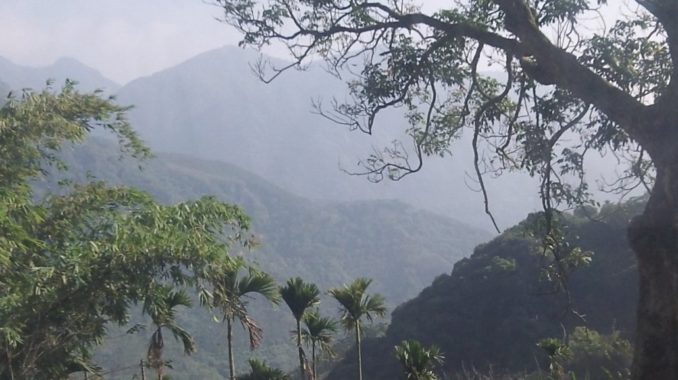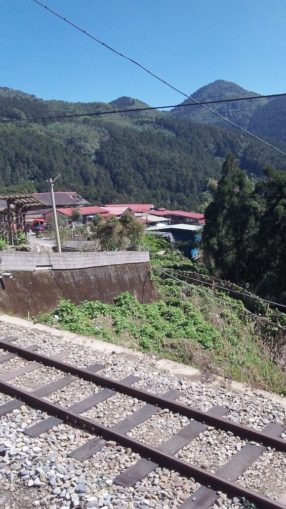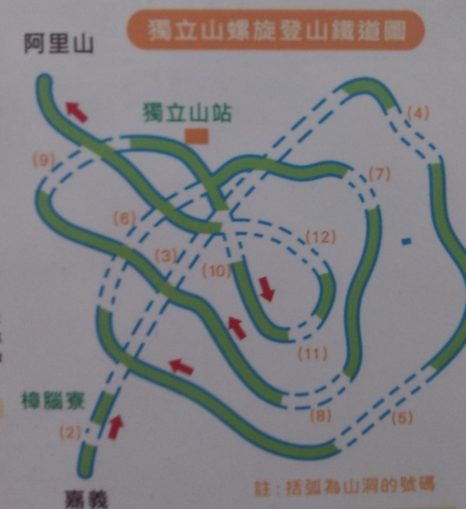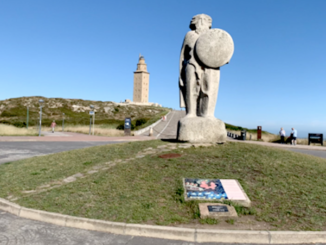
The Alishan Forest Railway runs from the coastal plain into the heart of Taiwan’s empty highlands. It was built in 1912 by the Japanese for the purpose of transporting timber from the mountains for the home construction industry in Japan, and was never intended as a passenger service. Despite this, it bills itself — fairly, I came to think — as one of the most spectacular narrow-gauge railway journeys in the world.
But it sure did not inspire confidence as a business. The Alishan Forest Railway ticket office — the terminus abuts the Jiayi mainline station — seemed to be operating that morning without the help of electricity. The vendor was manually scribbling numbers onto the tickets, which were coarsely and unevenly edged, as though they had been hastily cut out of a big piece of cardboard with kitchen scissors. The train itself, a slightly scaled-down version of an ordinary branch line train, came with a disturbingly large complement of engineers and maintenance guys in orange jackets. They milled about on the platform tapping wheels and consulting clipboards, outnumbering the waiting passengers.
But the four coaches soon filled up. Hauled by an orange shunter, we trundled out of Jiayi the back way, edging past suburban yards, clothes-drying racks and tool-sheds until we reached open country. The Alishan line attracts superlatives, and after about twenty minutes I had another to add to the list — this was undoubtedly the slowest train I had ever ridden on. Looking at the brochure, I saw it takes nearly two-and-a-half hours to cover 86 km, which, if the line were on the level, would be slower than a good cyclist. We lumbered through a string of hamlets and farmyards, within a few feet of country people sitting on their doorsteps or standing holding buckets and paddy sickles. They stared gormlessly back at us, as if they had never seen a train before. Progress was so slow you could almost have done a quick sketch of some of these bucolic scenes.
Once we finally left the fields and plantations, however, this journey got interesting. After Zhuqi, the only real town on the line, the train began to climb, and the disturbingly large complement of engineers and maintenance guys in orange jackets became more animated. Three of them positioned themselves up front, blocking the public’s view as they peered out anxiously for rockfalls, bridge collapses, landslips and other hazards that this line is prone to. I did not know this at the time, but another superlative associated with the Alishan line is Probably the World’s Most Dangerous Railway. Its safety record is breathtakingly awful. On 24 April 1981, a collapsed tunnel resulted in nine deaths and 13 injuries. On 1 March 2003, 17 people were killed and 156 injured in a derailment near Alishan station. Five tourists, including three from mainland China, were killed and 113 people injured in another derailment on 27 April 2011. (Bear in mind that a “derailment” along this line can mean a three-hundred foot drop into a ravine, the descent slowed only by enoki trees.) On top of this, the whole line was still recovering from a monster typhoon, and the final section, to Alishan station, was closed. You have to admire the perseverance, though. There cannot be many major tourist attractions around the world that regularly kill and maim their customers in significant numbers and yet somehow stay in business.

But I was glad they had persevered. This truly was a ride like no other. For a long time, we burrowed through a deep mist, through which you could just make out walls of forest, glimpses of ravine and, at regular intervals, clusters of engineers and maintenance guys in orange jackets by the line-side. Station platforms were makeshift or absent altogether, entailing quite a jump down; this was never a proper passenger line. We corkscrewed our way up the Mt. Duli spiral, a remarkable piece of tunnel engineering for gaining height quickly that, on the design plan, looked like a sailor’s knot.
Then, to a soundtrack of aboriginal chanting, we broke through the cloud belt. We had zigzagged our way to an elevation of 4,000 feet, and the scene that opened up as we reached the sunlit uplands was celestial. You were looking down on hilltops and into deep green valleys with tiny villages, not from an airplane but a train seat. I couldn’t get my head around that. Above, the high peaks soared, their flanks all cloaked in forest and scrub, from which solitary, branchless palm-like trees poked up, with foliage like green mop-heads. The cool, clear air coming through the open windows was bracing and the splendour inspiring.
This was the Taiwan you never hear about: the reason the Portuguese called it Isla Formosa, and the Taiwanese themselves Baodao, the Jewel Island. The coastal plain may be one of the world’s most crowded places, but the mountains running down the eastern half of the country create the same paradoxical impression of infinite emptiness that you get in the high ranges of equally overpopulated Japan. No railway, and only a few main roads, cross these mountain ranges. A determined army could hold out for years in the deep forests and remote valleys. The Japanese had indeed taken years to pacify the interior, resorting to outright barbarism in their frustration, and they were up against tribesmen with bows and arrows. An invasion of Taiwan by the PRC would be less of a walkover than its overwhelming military advantage might suggest.
It turned out that not just a section but the whole of the last third of the line was closed, rather more than I had assumed, though the operator’s resources had not run to updating its maps and schedules, which were still marketing the trip as ending at Alishan. The journey in fact ended at a large village called Fenqihu, which, from the hu in its name, should have been by a lake, though I did not see one. Originally developed by the Japanese as a coaling station and lumber depot, after the discovery of what the blurb puzzlingly called a “secret forest” in 1896, it was now a traditional mountain resort, though it remained worldly enough to have a Seven-Eleven. It was a hiker’s jump-off point really; there were plenty of well-signposted paths, but few other attractions.

The tourists that come here, they told me at the station, are mainly from the Chinese-speaking countries. Most mainlanders, it seemed, go on to Alishan, by other means. Alishan, a group of mountains peaking at 2,663 meters, features in mainland schoolbooks as one of ancient China’s mystical ranges. For them, it is almost a place of pilgrimage, all the more so as it was forbidden territory until very recently.
After a quick bowl of bamboo shoot soup, which had a pleasant, mildly leafy taste, I dropped in at the little steam-engine museum back at the station. One of the handy things about running a knackered old railway as a tourist attraction is that when the engines finally conk out and fall to pieces you can simply put them in a shed, hang a couple of paragraphs of history notes on the wall, and, hey presto, you have a museum to complement the preserved line (and are probably eligible for Ministry of Culture funding too). This was evidently what had happened here, but it was actually quite interesting, or it was if you are a nerd like me whose idea of fun is pottering around looking at antique industrial equipment. Both little locos were American-built, and were in service for fully 70 years before being retired in the 1970s.
Before leaving, Fenqihu, I did a quick 500-meter hike up one of the mountain paths, far enough to get me properly into the woods and also leave me gasping for breath, for I wasn’t ready for this kind of exertion yet. The stone steps and lanterns reminded me of Japan, and I was not surprised to learn from a plaque that during the Japanese occupation (1895-1945), an imperial shrine had been set up nearby. These had been placed all over Taiwan as part of a drive to fully assimilate the Taiwanese into the Japanese empire. Both the colonialists and their subjects were expected to worship there. Shinto is a religion that reveres nature, and would probably have come naturally to ordinary people in the Taiwan, where the earth gods still have their temples and followers.
From Baodao, my Taiwan travelogue (2015), viewable and downloadable here: Baodao
© Joe Slater 2018 2024
The Goodnight Vienna Audio file
Audio Player



